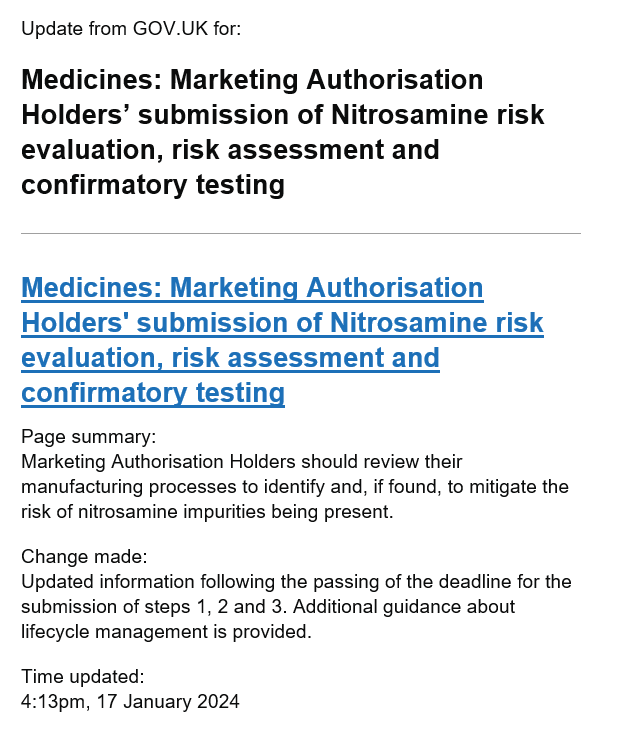Medicines: Marketing Authorisation Holders’ submission of Nitrosamine risk evaluation, risk assessment and confirmatory testing.
The scope of the review has been widened to cover all medicinal products for human use. For example, it includes medicinal products containing chemically synthesised active pharmaceutical ingredients, as well as biological medicinal products) authorised in the UK, Great Britain (England, Scotland and Wales) and Northern Ireland
Guidance Document
IDRAC_373773_07-Nov-2023_MHRA Guidance_ Medicines_ Marketing Authorisation Holders’ Submission of Ni.pdf (149.0 KB)
Nitrosamines impurities in medicines
IDRAC_373778_07-Nov-2023_MHRA Guidance_ Nitrosamines Impurities in Medicines, 24-Aug-2023.pdf (102.6 KB)
Useful remarks:
Common mistakes in nitrosamine submissions
We frequently encounter the following issues:
•Lack of initial submission details (e.g. Ames test, method validation, batch data)
•Incorrect use of step 2 cover letter templates
•Inaccurate declaration of LTL concept use
•Unclear or missing step 3 proposals
•Timelines not adhered to for step 1 and 2 submissions
•Misinterpretation of Call for Review scope
•Improper calculation of limits based on SmPC’s MDD
•Inadequate sensitivity of analytical methods
•Incomplete risk evaluation and assessment
•Insufficient details in read-across proposals
•Omission of batch information, burn rate, market share, and test data
Releasing batches with nitrosamines below AI
Products with nitrosamines < AI are safe for patients and can be marketed, requiring step 2 submission.
Releasing batches with nitrosamines above AI
Products surpassing AI are evaluated for LTL concept applicability, assessment outcomes are shared with companies. Immediate step 2 submission is required upon nitrosamine detection > AI, and DMRC should be contacted.
Temporary use of less-than-lifetime concept
Under specific circumstances, LTL concept can be used if aligned with EMA/CMDh Q&A, with product supply criticality considered. Detailed clinical & safety data is essential for concept justification.Batch details, burn rate, market share, expiry date, and nitrosamine data should be included. Note that these concepts are temporary, and a proper AI should be used long-term.
Testing during establishment of new nitrosamine AI
Pending new nitrosamine AI, routine batch monitoring is advised to detect mutagenic impurities. Testing/skipping testing for products <10%/<30% of the general AI (18 ng/d) can be justified with appropriate batch data.
Chloramine consideration in risk assessments
MHRA does not have a set chloramine limit in purified water. Risks tied to water use should follow general risk assessment guidelines based on local purification systems.
Assessing new nitrosamines for toxicology
ICH M7 principles and EMA’s Q&A document guide AI development. Expert assessment using a weight of evidence approach is required. Negative Ames test supports an AI of 1.5μg/day. In vivo mutagenicity study results determine non-mutagenic impurity control.
Meeting call for review timelines
MHRA don’t plan to extend Call for Review timelines. Unmarketed products are step 2 exempt without available test data. Step 3 may be delayed accordingly. Product marketing should follow completed step 2 and 3.We remind Market Authorisation Holders (MAHs) of their obligations under HMR Part 5, Reg 75(2) and 75(4)
